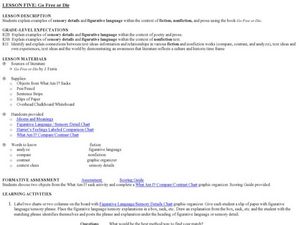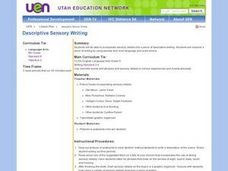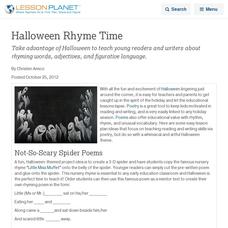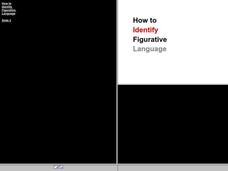E Reading Games
Orpheus the Lyrical – Figurative Language Review Game
Turn grammar practice into a game, a video game this is! Scholars show what they know about figurative language with a video game that takes them through a land filled with coins, magic, and animals. Concepts include similes, metaphors,...
Curated OER
Go Free or Die: Figurative Language
Figures of speech, sensory details, and academic language are all targeted while reading Chapter Two of J. Ferris’ Go Free or Die. First, learners engage in an exercise to practice describing with detail. Then, partners use a chart to...
Curated OER
Figurative Language Project
Want a handy way to remember the difference between metaphors and similes, or allusions and alliteration? Individuals craft their own figurative language booklet, complete with definitions, examples, and illustrations, following...
Mailbox Education Center
On the Hunt: Understanding Figurative Language
Young writers hunt for examples of figurative language in their reading. The hunt requires pupils to cite their sources, record a quoted example for each type of figurative language, and an explanation of what they think the examples...
Curated OER
Exploring Figurative Language in Fiction and Nonfiction
A reading of Pat Street's There's a Frog in My Throat launches a study of figurative language. Using a pocket chart, display one phrase containing figurative language. Class members choose the best explanation from three choices offered....
Poetry Society
How do Poets Use Language?
Why do writers choose the language they do? Here's a resource that has the poet himself answer that very question. Joseph Coelho explains why he chose the words and images he used in his poem, "If All the World Were Paper."
Curated OER
Go Free or Die
Groups of older elementary learners begin their study of figurative language by visiting a website and completing the exercises detailed there. They then apply what they have learned by finding examples in several poems. Finally, they...
K12 Reader
Proverbs and Adages Match
The grass may be greener on the other side, but a instructional activity about proverbs and adages is sure to help readers of all levels master figurative language. Kids match the idioms in the first column to their literal meanings in...
K12 Reader
Animal Proverbs and Adages
What will play when the cat's away? Practice figurative language with a list of proverbs about animals. Kids use the word bank at the top of the page to fill in the blanks based on their knowledge of common phrases.
Curated OER
Hyperbole Lesson Plans: Ideas for the Art of Exaggeration
Hyperbole lesson plans and ideas that make figurative language instruction relevant to students' lives. Discover how to help learners better understand the figurative concept of hyperbole. A fantastic article which includes multiple web...
Curated OER
"Snapshot" Exercises & Sensory Detail Word Bank
Read a sample of creative descriptive writing to your science class. Discuss how writing can be used to record and communicate observations that scientists make. Reading selections and thought-provoking questions are suggested. Also...
Curated OER
Details, Details, Details
Writing can become one-dimensional if authors don't involve all their senses. First, scholars observe a strange object which, ideally, they can touch and even smell. Without using certain words (you can create a list or have the class...
Curated OER
Simile and Metaphor- Poetry Toolbox
Illustrate the connection between using figurative language (specifically similes and metaphors) and creating poetry. First this worksheet reviews the definition for each, and then writers create the endings to two examples provided....
Curated OER
Figurative Language Academy Awards
Students examine figurative language in writing. Students demonstrate simile, metaphor, and personification in their own writing.
Curated OER
Descriptive Prompt: Precise Language
Incorporate sensory details into a piece of descriptive writing. First, elementary and middle schoolers improve a piece of writing by using precise, vivid language, as well as appropriate word choice. They then listen to a variety of...
K12 Reader
Improve Your Writing with Similes
A language arts worksheet works like a dream. Class members become as busy as bees as they complete a activity geared toward similes. The layout of the sheet is as clear as crystal, with directions that are easy to follow.
Curated OER
Metaphors
Metaphors open doors to descriptive language for your poets. They read the poem "What is the Sun" and record all the metaphors they find. Then, scholars change one of them to a simile. After answering two more comprehension questions,...
Curated OER
Discovering Angel Island: The Story Behind the Poems
Poems carved into the wooden walls of the Asian immigrant prisons on Angel Island provide upper elementary graders an opportunity to study not only the story behind the poems but to also focus on the figurative language employed by the...
Curated OER
Halloween Rhyme Time
Take advantage of Halloween to teach young readers and writers about rhyming words, adjectives, and figurative language.
Curated OER
How To Identify Figurative Language
Students investigate writing techniques by analyzing a chart. In this figurative language lesson, students define similes, metaphors and identify the difference between them and personification. Students demonstrate their understanding...
Curated OER
Eating Up Idioms
Ah, food idioms! Now that sounds tasty. Class members read and discuss various food-related idioms, create an illustration of a food-related idiom, and develop a class book or bulletin board to celebrate figurative language and National...
Curated OER
Chalkboard Challenge: Literary Terms
This interactive PowerPoint simulates a "Jeopardy" game that addresses figurative language, cause and effect, and other literary terms. Players can chose which category and amount they would like to play on the Game Board.
Curated OER
Edward Lear, Limericks, and Nonsense
Introduce your class to the delights of nonsense poetry and explore literary devices with the writing of Edward Lear. Learners identify rhyme and meter as well as figures of speech, alliteration, and onomatopoeia in "The Owl and the...
K12 Reader
Proverbs and Adages: What’s the Meaning?
Your kids have probably heard these idioms before, but do they know what they mean? Help them learn that haste makes waste, an ill wind blows no good, and that ignorance is bliss with a list of popular expressions.
Other popular searches
- Figurative Language Poetry
- Figurative Language in Poems
- Figurative Language Quiz
- Figurative Language Project
- Imagery Figurative Language
- Figurative Language Lessons
- Using Figurative Language
- Figurative Language Worksheets
- Figurative Language Test
- Figurative Language in Poetry
- Figurative Language Vocabulary
- Figurative Language in Prose

























